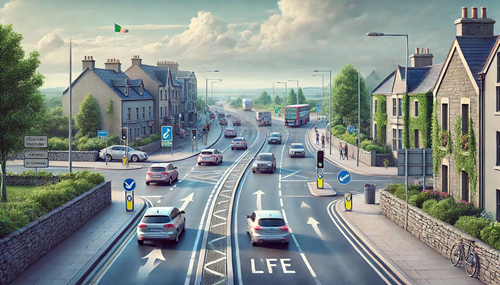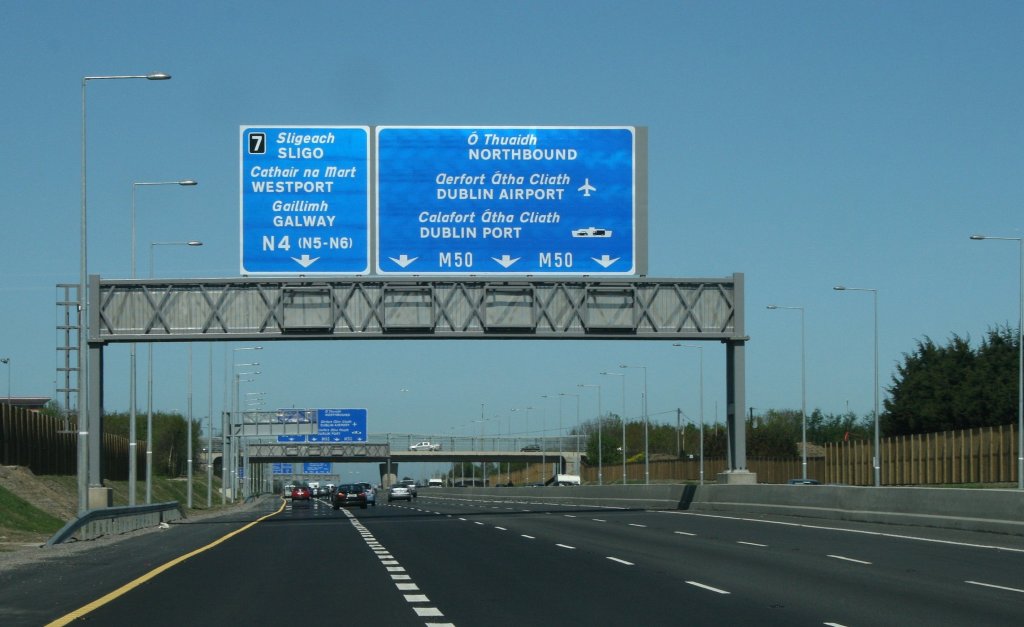In Ireland, you drive on the left side of the road. This rule applies to both the Republic of Ireland and Northern Ireland. Driving on the left is a common practice in many countries that were once part of the British Empire, ensuring consistency across these regions.

Additionally, vehicles in Ireland are typically right-hand drive, meaning the driver’s seat is on the right side of the car. Road signs and traffic regulations are designed to accommodate this driving orientation, making it essential for visitors to be mindful of this when traveling in Ireland.
Why Does Ireland Drive on the Left Side of the Road?

Ireland drives on the left side of the road due to:
-
Historical Influence: During medieval times, people preferred to keep to the left to keep their right arm—typically the sword arm—free for defense.
-
British Rule: As part of the United Kingdom until 1922, Ireland adopted the left-side driving practice standardized by the British Empire.
-
Consistency with British Territories: Driving on the left became a norm in British territories, and this tradition has continued in Ireland.
This adherence to left-side driving is deeply embedded in the country’s transportation laws and cultural heritage.
How Does Driving in Ireland Compare to Other Countries?
Driving in Ireland involves navigating vehicles on the left side of the road. This practice contrasts with the majority of the world but is common in the British Isles. Ireland shares this driving orientation with a select group of countries, making it an interesting case when comparing road rules internationally.
This orientation affects everything from car design to road signage and can influence a driver's experience, particularly for those accustomed to driving on the right. Approximately 30% of countries globally follow the left-side driving rule, aligning Ireland with nations like the United Kingdom, Australia, and Japan, among others.
United Kingdom
-
Ireland and the United Kingdom both drive on the left side of the road, which is deeply rooted in their historical and cultural ties.
-
The similarity in driving rules facilitates easier and more comfortable travel for residents crossing between the two regions, as there is no adjustment needed in driving orientation.
-
Consistent road signage and vehicle controls across Ireland and the UK help in reducing confusion and enhancing safety for drivers who travel between these countries.
United States and Canada
-
In contrast to Ireland, both the United States and Canada have adopted right-side driving.
-
Drivers from Ireland visiting or relocating to North America must adjust to the opposite road orientation, which involves mirrored vehicle controls and a different flow of traffic.
-
Planning for road trips in the United States or Canada requires Irish drivers to familiarize themselves with these changes to ensure safety and comfort during their travels.
Australia and New Zealand
-
Australia and New Zealand, like Ireland, mandate driving on the left side of the road.
-
This commonality in road rules makes it significantly easier for tourists and business travelers from Ireland to adapt when visiting these countries.
-
The shared norms in driving practices not only simplify international travel but also strengthen the bonds between these nations through easier mobility and understanding.
Mainland Europe
-
Most European countries, including popular destinations such as France, Germany, and Spain, follow the right-side driving convention.
-
When traveling to mainland Europe, Irish drivers must cope with the transition to right-side driving, which can be challenging especially in busy urban environments.
-
The adaptation involves learning to navigate different road layouts and obeying traffic rules that are oriented for right-side driving, essential for safety and compliance.
The unique aspect of driving on the left side in Ireland creates a distinctive driving culture that connects with other left-driving nations, while also posing interesting challenges when Irish drivers visit or move to countries with right-side driving. This situation underscores the global diversity in road rules and the adaptability required for international drivers.
What are the Key Rules for Driving in Ireland?
The key rules for driving in Ireland include driving on the left side of the road, which is a standard practice. Seat belts are mandatory for all occupants of the vehicle. Speed limits are set at 120 km/h (74 mph) on motorways, 100 km/h (62 mph) on national roads, 80 km/h (50 mph) on regional roads, and 50 km/h (31 mph) in urban areas.
Additionally, Ireland enforces strict alcohol limits: a blood alcohol concentration (BAC) of 0.05% for standard drivers and 0.02% for professional and learner drivers.
Drive on the Left
In Ireland, it is imperative to always drive on the left-hand side of the road. This rule is crucial for preventing head-on collisions and is particularly important for tourists who may be accustomed to driving on the right. When overtaking, do so on the right but return to the left as soon as it's safe.
Speed Limits
Adhere strictly to speed limits, which are clearly marked and vary depending on the type of road and the area. Urban areas and city, typically have a limit of 50 km/h, while regional roads have a limit of 80 km/h. Major motorways allow speeds between 100 km/h and 120 km/h. Always reduce speed in adverse weather conditions and in areas with special speed limits such as near schools.
Seat Belts and Child Seats
The use of seat belts is mandatory for all passengers in the vehicle, and failure to comply can result in fines and demerit points. Children must be seated in appropriate child restraint systems that match their age and size until they are tall enough to use an adult seat belt safely.
Alcohol Limits
Ireland enforces strict laws regarding driving under the influence of alcohol. The legal limit for most drivers is a blood alcohol concentration (BAC) of 0.05%. Novice, professional drivers, and motorcyclists must adhere to an even lower BAC limit of 0.02%. It is highly advised to avoid alcohol completely if planning to drive.
Use of Mobile Phones
Using a mobile phone while driving is illegal unless it is operated via a hands-free system. This law includes making calls, texting, or handling the phone in any capacity, which can lead to significant distractions and accidents.
Roundabout Rules
Navigating roundabouts requires drivers to give right of way to all traffic approaching from the right. Motorists already circulating within the roundabout have priority over those attempting to pass or enter. Always signal your intended exit direction well before you leave the roundabout.
Can You Drive in Ireland With a US License?
Yes, you can drive in Ireland with a US license. I remember the first time I drove there; adapting to the left side of the road was an intriguing challenge but quite manageable with a US license. The roads are well-marked and locals are generally patient with tourists adjusting to the traffic lights and the different driving side. Just ensure your license is valid and you're aware of local driving laws to enjoy a smooth experience.
Do You Need an International Driver’s License To Rent a Car in Ireland?
No, you do not need an international driver’s license to rent a car in Ireland if you have a valid driver's license from your own country that is in English. However, if your license from foreign country is not in English, an International Driving Permit is required to accompany your national driving license.
From personal experience, navigating the left-hand driving system in Ireland was straightforward with my U.S. driver's license. Rental car park and agencies just checked to ensure my license was valid and that I was comfortable with the road orientation, which mirrors that of the UK. Remember, always keep to the left side of the road and take it slow at roundabouts if you're used to driving on the right!
Can You Get an Irish Driving Licence if I Live in Northern Ireland?
Yes, you can get an Irish driving licence if you live in Northern Ireland. I moved to Belfast a few years ago and successfully applied for an Irish licence. The process was straightforward and required the usual proof of residency and identity. This flexibility is due to the unique agreement between the UK and Ireland, which simplifies cross-border travel and documentation, reflecting their shared history of bi-directional driving conventions.
Tips for Driving in Ireland
In Ireland, vehicles drive on the left side of the road. Adjusting to this can be initially challenging for those accustomed to driving on the right. When I first drove in Ireland, I rented a car from one of the car rental companies, and I found that frequent reminders and extra caution at intersections helped me adapt more quickly. It's crucial to be mindful of this difference, especially when making turns or navigating roundabouts. Here are some additional tips to ensure safe and enjoyable driving in Ireland:
-
Stay Left: Always remember to keep left unless overtaking. It can be easy to revert to habit, so keep this rule at the forefront of your mind.
-
Roundabout Rules: At roundabouts, give way to traffic from the right and signal your exit. It took me a few tries to get used to it, but patience and attentiveness go a long way.
-
Speed Limits: Observe the local speed limits, which are typically posted in kilometers per hour. Rural roads can be narrow and winding, requiring slower speeds.
Seat Belts: Everyone in the vehicle must wear seat belts at all times. This is not just a legal requirement but a necessary precaution on Ireland’s sometimes unpredictable roads.
-
Headlights: Use dipped headlights in poor visibility conditions, including rain or fog, which are common in Ireland.
-
Hire Car: If renting a car, choose a model you are comfortable with. Automatic transmissions can be easier if you are not used to shifting gears with your left hand, especially if you typically drive a stick shift.
-
Navigation: Use a reliable GPS to help navigate, especially if you’re not familiar with the area. It saved me more than once from taking a wrong turn into oncoming traffic.
-
Gas Stations: Be aware that gas stations can sometimes be far apart, especially in rural areas, so plan your fuel stops accordingly. Stopping at a gas station before you run too low on fuel can prevent unnecessary stress.
By keeping these tips in mind and staying vigilant, you can enjoy the beautiful drives across Ireland safely and comfortably.
FAQs On What Side of the Road Does Ireland Drive On?
1. What side of the road does Ireland make cars drive on?
Ireland drives on the left side of the road. This aligns with several other countries in the region, ensuring consistency for drivers who travel between the UK and Ireland.
2. Is it mandatory to drive on the left side secondary roads throughout Ireland?
Yes, it is mandatory to drive on the left side of the road across the entire country of Ireland. This rule applies to all vehicles on the road.
3. What other street signs should foreign drivers be aware of when driving in Ireland?
Foreign drivers should be particularly cautious about road signs and lane usage, as driving on the left can be unfamiliar. It's advisable to familiarize yourself with the vehicle's controls and road rules before driving.
4. Are there penalties for driving on the wrong side of the road in Ireland?
Yes, driving on the wrong side of the road in Ireland is a serious offense and can result in heavy fines, penalty points on your driving license, or even prosecution.
5. How does driving on the left impact road safety in Ireland?
Driving on the left is a standard safety measure in Ireland that reduces the top speed limit, risk of head-on collisions and improves the flow of traffic, contributing to overall road safety.
